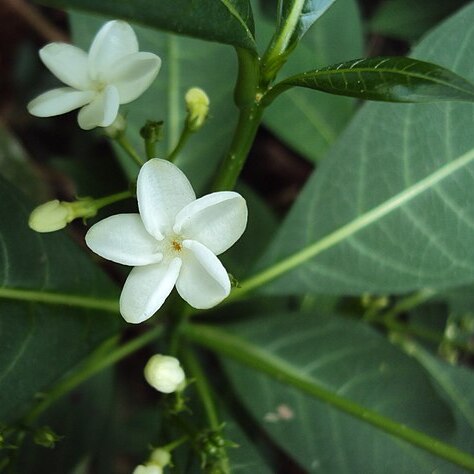Shrub 0.5-5 m high. Branches slightly lenticellate; branchlets glabrous. Leaves confined to the apex of the branchlets, usually in whorls of 3 or 4, sometimes also opposite; petiole 0.2-2 cm long, glabrous; blade papery, obovate to elliptic, 5-25 by 2.2-10 cm, 2-4.5(-6.5) times as long as wide, apex acuminate to cuspidate, base cuneate to slightly decurrent, glabrous above and beneath; secondary veins 6-13 pairs, 0.5-2.5 cm spaced, arcuate-ascending, rarely straight, forming an angle of (45-)55-85° with the midrib. Inflorescence 3-12 cm long, usually in whorls of 3 or 4, rarely solitary, lax, 8-24(-more than 35)-flowered; peduncle 3-7.7 by 0.1-0.2 cm, rather delicate, glabrous; pedicels 0.2-1.2 cm long, glabrous. Sepals ovate to subtriangular, very variable in size even within a single cyme, 2-5.5 by 0.8-1 mm, 2-7 times as long as wide, apex acute to acuminate, glabrous. Corolla white or slightly pinkish, 11-19 mm long in the mature bud and forming an ovoid to narrowly ovoid head of 1-2 by 2-5 mm, glabrous outside, villose from just below the mouth to about 3 mm below the insertion of the stamens; tube 9-17 mm long, 2.5-8 times as long as calyx, (2-)3.5-5 times as long as lobes, straight to slightly twisted; lobes suborbicular to obliquely ovate, 2-4.5(-6.5) by 2-3.5(-6) mm, 1-1.5 times as long as wide, obtuse to rounded. Stamens inserted at 6-10 mm from base, 0.4-0.7 of the length of the corolla tube; filaments 0.8-1 mm long; anthers 1-1.5 by 0.3-0.6 mm, 2.2-4.3 times as long as wide. Disk cup-shaped, 0.8-1.4 by 0.6-1 mm, 0.4-0.6 times as long as the ovary, slightly crenate. Pistil mostly glabrous; ovary 1.2-2.1 mm high, consisting of 2 carpels which are free from each other; style filiform, 4-6.5 mm long; style head 0.6-1.1 mm long. Fruit whitish purple when mature, usually of paired mericarps free from each other, with a very short stalk, sometimes only 1 carpel developing, ovoid, sometimes rather straight on one side and convex on the other side, 9-14 by 4.5-7 mm, 1.7-2.5 times as long as wide, apex acute to obtuse. Seeds 1, obliquely ovoid, 7-11 by 4-5 mm, 1.7-2.5 times as long as wide, acute at both ends, glabrous.
More
Shrubs to 3 m tall, erect, glabrous. Branchlets pale gray, lenticellate. Lower leaves opposite, terminal leaves in whorls of 3 or 4; petiole 0.5-1.5 cm; leaf blade narrowly to broadly ovate or oblong, 3.5-25 X 5-13 cm, nearly papery to membranous; lateral veins 6 or 7 pairs. Cymes rather lax, 3-9 together; peduncle 2-15 cm. Pedicel 3-6 mm. Corolla white, tube cylindric, 1-1.8 cm, inflated and villous from middle to throat; lobes broadly elliptic or ovate, 1-4.5 mm. Stamens inserted at middle of corolla tube. Ovaries distinct. Drupes ellipsoid or ovoid, distinct, ca. 10 X 5 mm. Seed 1. Fl. Feb-Oct, fr. Apr-Dec. 2n = 22*.
Lowland, montane rain forests, monsoon forests, brush fields, river banks, rice fields, seashores; at elevations from near sea level to 1,700 metres in southern China.

